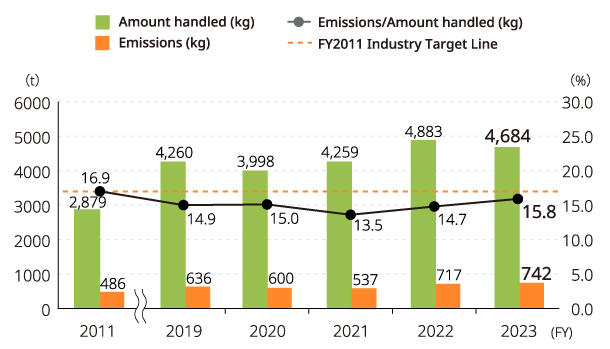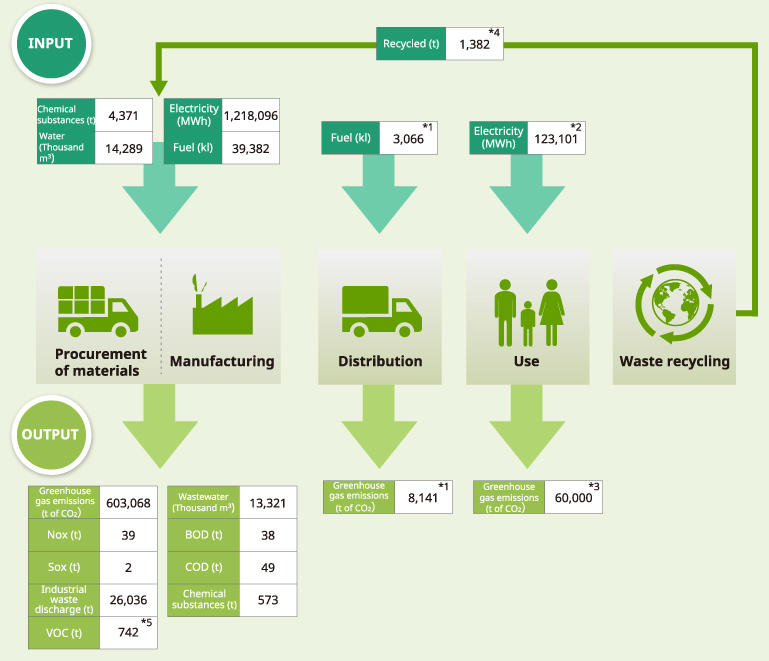Initiatives to Prevent Environmental Pollution
Environmental Compliance
The Kyocera Group has established autonomous environmental management standards for each site that are stricter than statutory and public regulations on emissions, wastewater, soil, groundwater and other areas of concern. We take periodic environmental measurements to ensure thorough compliance.
In FY 2023, the Kyocera Group received 2 complaints regarding environmental laws, regulations, and administrative guidance, and 3 complaints about noise, all of which have been promptly corrected and addressed.
Number of violations of laws and regulations*
| Violations of laws and regulations, administrative guidance | Complaints | ||||
|---|---|---|---|---|---|
| Water quality | Air quality | Wastes | Other | ||
| FY2023 | 2 | 0 | 0 | 0 | 3 |
Principal Kyocera Group sites in Japan, and some of our overseas sites, have acquired integrated ISO14001 certification
Control of Chemical Substances
Some chemical substances can cause environmental pollution and/or affect human health and the ecosystem. The Kyocera Group sets a voluntary control standard and takes initiative in carrying out environmental impact mitigation activities.
The Kyocera Group (Japan) carries out thorough control of emissions and the transferred amount of Class I Designated Chemical Substances as prescribed by PRTR Law. We also control the handling volumes and emissions of volatile organic compounds (VOC), which are a source of suspended particulate matter and photochemical oxidants.
Volatile Organic Compound (VOC)
Kyocera's non-consolidated (Japan) atmospheric emission rate (emissions/volume handled) in FY2023 was 15.8% compared to FY2011 levels of 16.9%. This result achieved the direction set by the Japan Electronics and Information Technology Industries Association (JEITA), which established voluntary guidance to prevent VOC emission rates from worsening from FY2011 levels.

Data in FY2022 have been updated to improve the accuracy of data aggregation for some locations.
Reports on Soil and Groundwater Contamination
The Kyocera Group (Japan) conducts soil surveys and provides survey reports to competent local governments according to the Soil Contamination Countermeasures Act.
Consequently, a total of seven locations were designated as areas which require action under the Act: Asahi City, Chiba, in 2013; Ebetsu City, Hokkaido, in 2014; Hachioji City, Tokyo, in 2014; Mikasa City, Hokkaido, in 2015; and Kawasaki City, Kanagawa in 2019; Daito City, Osaka in 2021; Hiki-gun, Saitama in 2022; Kirishima City, Kagoshima in 2023. No confirmation of any spread to or impact in the surrounding areas of those sites has been reported.
We are taking appropriate measures in close cooperation with each associated municipality.
Overall Environmental Impact
The Kyocera Group (Japan) tracks and manages business activities and environmental impact.
Data from the procurement, manufacturing, distribution, use, disposal, and recycling stages are used at each stage to formulate policies and analyze and evaluate the results to effectively reduce environmental impact.

- In accordance with the Act on the Rational Use of Energy, we calculate the distribution-related impact based on report data such as the use of energy in transportation by the specified consigner (Kyocera).
- We calculate the annual power consumption of the main products we sold in FY2023 (printers, multifunctional products, smartphones, etc.).
- We calculate the annual greenhouse gas emissions of the main products we sold in FY2023 (printers, multifunctional products, smartphones, etc.).
- We calculate the weight of toner containers and Multifunction printer reused and total amount of toner containers recycled in FY2023. (Kyocera Document Solutions Inc.)
- The VOC aggregate range shows data for Kyocera Corporation sites in Japan.
INPUT items
| Chemical substances | Consumption of substances covered by PRTR Law (Class I Designated Chemical Substances) |
|---|---|
| Water | Consumption of tap water, industrial water, and groundwater |
| Electricity | Consumption of electricity purchased from electrical power companies |
| Fuel | Consumption as energy of gas, light oil, heavy oil etc. (crude oil conversion) |
OUTPUT items
| Greenhouse gases | Emissions of CO2 and PFC etc. (6 types) as a consequence of using electricity, gas and fuel |
|---|---|
| NOx | Impact of nitrogen oxides associated with the combustion of gas, fuel, etc. |
| SOx | Impact of sulfur oxides associated with the combustion of fuel |
| Industrial waste | Industrial waste discharge generated in the course of our business activities |
| Wastewater | Volume of wastewater discharged into rivers etc. (Excluding wastewater discharged into sewage systems) |
| BOD | Impact of biochemical oxygen demand |
| COD | Impact of chemical oxygen demand |
| Chemical substances | Emissions and transferred amount of substances covered by PRTR Law (Class I Designated Chemical Substances) |
| VOC | Emissions of 20 VOC into the atmosphere |
Corporate Motto / Management Rationale
- Our Thoughts on Sustainability Activities
- Top Management Message
- Kyocera Group's Value Creation Model
- Sustainability Management
- Kyocera Group CSR Guidelines
- Stakeholder Engagement
- Environmental Safety Policy / Targets and Promotion System
- Measures to Fight Climate Change -Information Disclosure Based on TCFD Recommendations-
- Water Risk Response
- Recycling Activities
- Initiatives to Prevent Environmental Pollution
- Conservation of Biodiversity
- Environmentally Friendly Products / Green Procurement
- Environmental Communication
- A History of Our Environmental Protection Activities
Social Citizenship Initiatives
- The Kyocera Group Human Capital
- Respect for Human Rights
- Promoting Diversity and Inclusion
- Occupational Safety
- Occupational Health, Safety, and Fitness Initiatives
- Supply Chain Management
- Approaches to Raising Quality and Customer Satisfaction Levels
- Social Contribution Activities
- Academic Advancement and Research
- Support for Culture and the Arts
- International Exchanges and Collaboration
- Environmental Protection Activities
- Local Community Activities
- Contributions to Society through Business Activities
Relevant data
- ESG Data Sheets
- Third Party Assurance of Environmental and Social Data
- Promoting Digitalization
- Innovation Management
- Integrated Report
- Employees Creating the Future
- GRI Standards Comparison Table
- Editorial Policy
- Participation in Sustainability Related Initiatives & External Evaluation
- News & Announcements

